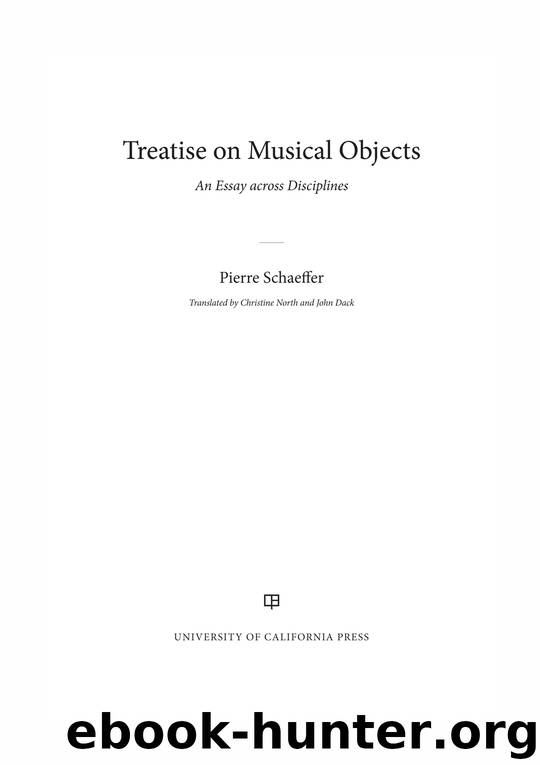Treatise on Musical Objects by Schaeffer Pierre;

Author:Schaeffer, Pierre;
Language: eng
Format: epub
Publisher: University of California Press
20.5. TWO PITFALLS
As we will see, it is all about invention, both musical and musicianly, without which we cannot help but fall back into classical ways of structuring, even well “intentioned.”
(a) We are trying to familiarize ourselves with sound. And so, with an inquisitive, attentive ear we listen to the creaking of doors and the singing of birds. We do, indeed, discover what we said: an easy structuring that enables sources to be identified. One door can be told from another, and the chaffinch from the warbler. So we find something familiar to the musical: a timbre and melodies. In fact, we have already gone beyond sound. We suddenly find ourselves at the highest level of structure and meaning, which seems natural to us. Even if the languages of the birds are incomprehensible to us, we hear them, by and large, as we would hear a foreign language system. In any case there is no reason why we should not make a study of their throats and the sounds they make, with the aid of the Sonagraph, which would introduce us to a phonetics of bird modulations but with a code that would probably remain impenetrable to us, for if bird language has meaning, it is, clearly, on another level.2
Where the door is concerned, it is quite another matter. Unlike the birds, it is not trying to communicate (the wind is moving it, not a speaker who might be using it as part of a code). Its activity, nevertheless, has a meaning, here focused on the event, and its “language,” metaphorically speaking, comes from the wind playing with the door. If a composer comes forward and substitutes himself for the wind, our interest changes direction. His agency may make a whole door solo or a dialogue between a door and a sigh meaningful or expressive.3 Is this music yet?
Let us say that here we have a study in instrumental modes of play and (musical) instinct, a very interesting experiment. Limited in this way to a domain of objects defined by their common source, the experimenter, here a composer, explores the entire range of expression possible for these objects, resulting from the variety of playing modes available to the instrument. There can be no better way of demonstrating the existence of meaning in the ordering of objects, even if we refuse them the status of musical objects. Thus experimental composition reveals the potential for undreamed-of ways of listening and some parallel system to be elucidated. This is not our aim, for, however odd it may seem, it concerns the higher level of composition and not the theory of objects suitable for research, which is our subject.
(b) One could even, in most cases, say that experimentation such as this in an instrumental domain is the main pitfall in research. We are only too tempted, in fact, at the beginning of a piece of research, to turn to instruments, to put sheet metal with sheet metal, ondes with ondes, membranes with membranes, and
Download
This site does not store any files on its server. We only index and link to content provided by other sites. Please contact the content providers to delete copyright contents if any and email us, we'll remove relevant links or contents immediately.
The Goal (Off-Campus #4) by Elle Kennedy(13210)
Kathy Andrews Collection by Kathy Andrews(11342)
Diary of a Player by Brad Paisley(7272)
What Does This Button Do? by Bruce Dickinson(5937)
Assassin’s Fate by Robin Hobb(5866)
Big Little Lies by Liane Moriarty(5526)
Altered Sensations by David Pantalony(4872)
Pale Blue Dot by Carl Sagan(4631)
Sticky Fingers by Joe Hagan(3916)
The Death of the Heart by Elizabeth Bowen(3345)
The Heroin Diaries by Nikki Sixx(3327)
Beneath These Shadows by Meghan March(3156)
Confessions of a Video Vixen by Karrine Steffans(3106)
The Help by Kathryn Stockett(3023)
How Music Works by David Byrne(2969)
Jam by Jam (epub)(2882)
Harry Potter 4 - Harry Potter and The Goblet of Fire by J.K.Rowling(2816)
Strange Fascination: David Bowie: The Definitive Story by David Buckley(2703)
Petty: The Biography by Warren Zanes(2578)
